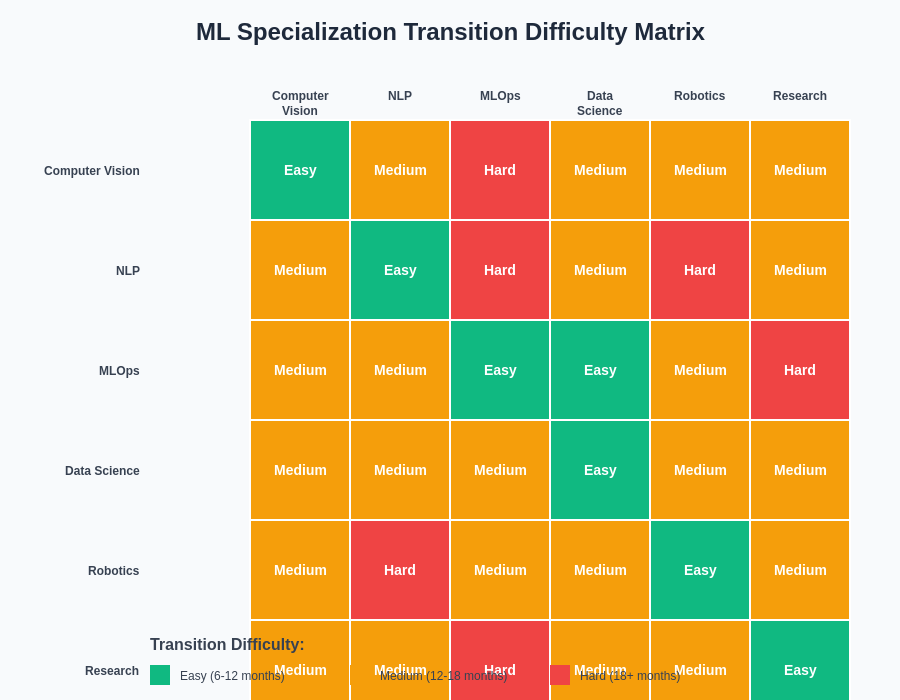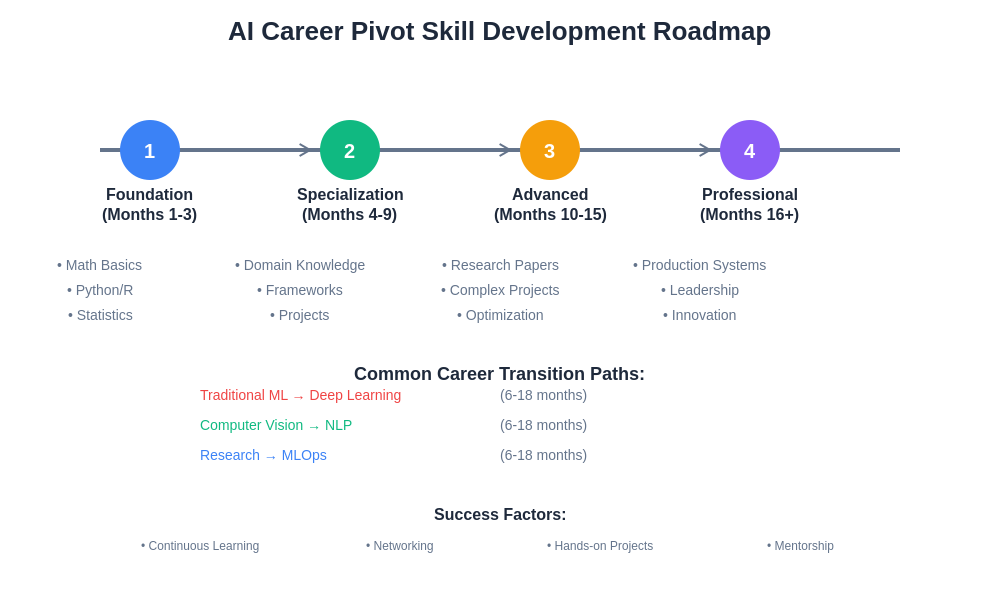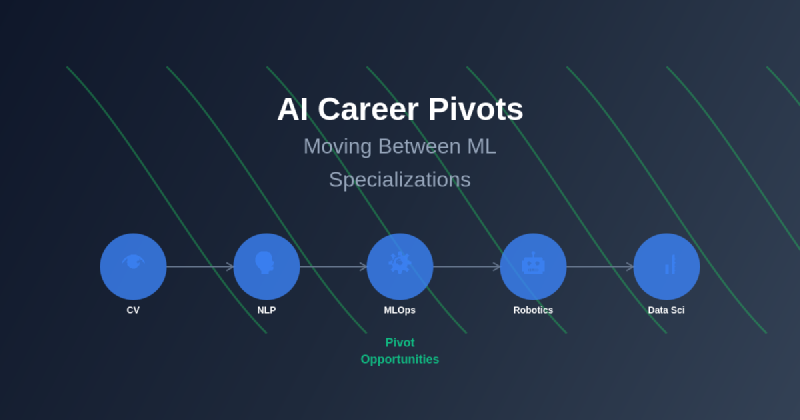The artificial intelligence industry has evolved into a complex ecosystem of specialized domains, each requiring distinct skill sets, methodologies, and expertise. As the field continues to mature and diversify, professionals often find themselves contemplating transitions between different machine learning specializations to align with market demands, personal interests, or career advancement opportunities. Understanding how to navigate these pivots successfully requires strategic planning, targeted skill development, and a comprehensive awareness of the interconnections between various AI disciplines.
Explore the latest AI career trends and opportunities to stay informed about emerging specializations and market dynamics that could influence your career trajectory. The landscape of AI specializations is continuously expanding, creating unprecedented opportunities for professionals willing to adapt and evolve with the industry’s changing demands.
Understanding the AI Specialization Landscape
The modern artificial intelligence field encompasses numerous specialized domains, each with its unique challenges, methodologies, and applications. Computer vision engineers focus on enabling machines to interpret and understand visual information from the world, developing systems that can recognize objects, detect patterns, and analyze imagery with human-like precision. Natural language processing specialists work on bridging the communication gap between humans and machines, creating systems that can understand, interpret, and generate human language in meaningful ways.
Machine learning operations professionals concentrate on the deployment, monitoring, and maintenance of ML systems in production environments, ensuring that theoretical models translate into robust, scalable real-world applications. Robotics engineers combine AI with mechanical systems to create intelligent machines capable of interacting with the physical world, while data scientists focus on extracting actionable insights from complex datasets using statistical methods and machine learning techniques.
Each specialization demands specific technical competencies, domain knowledge, and problem-solving approaches, yet they share fundamental mathematical foundations, programming skills, and analytical thinking patterns that facilitate transitions between domains. Understanding these commonalities and differences is crucial for professionals considering career pivots within the AI ecosystem.

The complexity of transitioning between different machine learning specializations varies significantly depending on the source and target domains, with some paths requiring minimal adaptation while others demand extensive retraining and skill development. This matrix provides a realistic assessment of the time and effort required for successful career pivots across major AI specializations.
Strategic Career Planning in AI
Successful career transitions in artificial intelligence require careful strategic planning that begins with honest self-assessment of current skills, interests, and long-term career objectives. Professionals must evaluate their existing technical competencies, identify transferable skills, and understand the specific requirements of their target specialization. This assessment should include both technical abilities such as programming languages, mathematical foundations, and domain-specific tools, as well as soft skills like communication, project management, and collaborative problem-solving.
Leverage advanced AI tools like Claude to enhance your learning journey and accelerate skill development across multiple ML domains through intelligent tutoring and personalized guidance. The strategic use of AI-powered learning tools can significantly reduce the time and effort required to master new specializations while providing comprehensive support throughout the transition process.
Market research plays a critical role in career planning, requiring professionals to understand industry trends, salary expectations, job market dynamics, and future growth projections for different specializations. This research should encompass emerging technologies, evolving business needs, and geographical considerations that might influence career opportunities and advancement potential.
Transitioning from Computer Vision to Natural Language Processing
The transition from computer vision to natural language processing represents one of the most common career pivots in the AI field, leveraging shared mathematical foundations while requiring adaptation to entirely different data modalities and problem-solving approaches. Computer vision professionals possess strong backgrounds in linear algebra, optimization techniques, and deep learning architectures that translate well to NLP applications, particularly in areas involving transformer models, attention mechanisms, and neural network design.
The primary challenge in this transition involves shifting from spatial reasoning about visual data to sequential and contextual reasoning about textual information. While computer vision focuses on understanding patterns in pixel arrays and geometric relationships, NLP requires comprehension of linguistic structures, semantic meanings, and cultural contexts that influence language interpretation. This shift necessitates developing expertise in linguistics fundamentals, tokenization strategies, embedding techniques, and language model architectures.
Practical transition strategies include starting with multimodal projects that combine vision and language tasks, such as image captioning, visual question answering, or document understanding systems. These bridge projects allow professionals to leverage existing computer vision expertise while gradually building NLP competencies in familiar contexts. Additionally, focusing on transfer learning applications, where pre-trained vision models are adapted for text-based tasks, provides a natural progression path that builds confidence while developing new skills.
Moving from Traditional ML to Deep Learning Specializations
The evolution from traditional machine learning to deep learning specializations represents a significant paradigm shift that requires both technical adaptation and conceptual reframing of problem-solving approaches. Traditional ML practitioners typically work with structured data, feature engineering, and interpretable algorithms like random forests, support vector machines, and linear regression, while deep learning specializations focus on neural networks, automatic feature learning, and complex model architectures that often operate as black boxes.
This transition requires developing proficiency in neural network fundamentals, backpropagation algorithms, and gradient-based optimization techniques that form the foundation of deep learning systems. Understanding architecture design principles, regularization techniques, and hyperparameter tuning strategies becomes essential for success in deep learning domains. Additionally, professionals must adapt to working with larger datasets, longer training times, and more complex computational requirements that characterize deep learning workflows.
The learning curve can be managed through progressive skill building, starting with simple neural network implementations and gradually advancing to more sophisticated architectures like convolutional networks, recurrent networks, and transformer models. Hands-on projects that demonstrate clear advantages of deep learning over traditional methods help build intuition and confidence while showcasing the practical benefits of the transition to potential employers or clients.
Pivoting to MLOps and Production Systems
The transition to MLOps represents a shift from research and development focus to production deployment and operational excellence, requiring professionals to develop expertise in software engineering, system architecture, and operational processes that ensure reliable AI system performance in real-world environments. This pivot often appeals to ML practitioners who enjoy the challenges of scaling theoretical models into robust, maintainable systems that deliver consistent business value.
MLOps professionals must master containerization technologies, orchestration platforms, monitoring systems, and continuous integration practices that enable reliable model deployment and maintenance. Understanding cloud platforms, distributed computing, and infrastructure automation becomes essential for managing the complexity of production ML systems. Additionally, developing expertise in model versioning, data pipeline management, and automated testing helps ensure system reliability and facilitates collaborative development processes.
Enhance your research and learning capabilities with Perplexity to stay current with rapidly evolving MLOps tools, platforms, and best practices that define modern production AI systems. The transition to MLOps requires continuous learning about emerging tools and methodologies that improve system reliability and operational efficiency.
The career transition involves shifting from algorithm optimization and model accuracy metrics to system performance indicators, uptime requirements, and business impact measurements. This change in perspective requires developing business acumen, stakeholder communication skills, and understanding of operational constraints that influence ML system design and deployment decisions.
Exploring Emerging Specializations
The AI field continuously spawns new specializations as technology advances and business applications expand, creating opportunities for professionals to pioneer emerging domains while leveraging existing expertise. Quantum machine learning combines traditional ML approaches with quantum computing principles, requiring understanding of quantum mechanics, quantum algorithms, and hybrid classical-quantum systems. This emerging field offers significant potential for professionals with strong mathematical backgrounds and interests in cutting-edge computational paradigms.
Ethical AI and AI safety represent growing specializations focused on ensuring responsible development and deployment of artificial intelligence systems. These domains require combining technical expertise with understanding of ethics frameworks, regulatory compliance, and societal impact assessment. Professionals transitioning to these areas must develop skills in bias detection, fairness metrics, interpretability techniques, and risk assessment methodologies.
Neuromorphic computing represents another frontier specialization that mimics brain-inspired computing architectures to create more efficient and adaptive AI systems. This field requires understanding of neuroscience principles, specialized hardware architectures, and novel programming paradigms that differ significantly from traditional computing approaches.
Building Transferable Skills
Successful career pivots in AI rely heavily on identifying and developing transferable skills that provide value across multiple specializations while serving as bridges between different domains. Mathematical foundations including linear algebra, calculus, probability theory, and statistics form the bedrock of most AI specializations and provide a common language that facilitates transitions between technical domains.
Programming proficiency in languages like Python, R, and SQL remains valuable across specializations, though specific libraries, frameworks, and tools may vary between domains. Understanding software development best practices, version control systems, and collaborative development workflows provides utility regardless of the specific AI application area. Additionally, data manipulation, visualization, and analysis skills prove valuable across virtually all AI specializations.
Problem-solving methodologies, experimental design principles, and analytical thinking patterns developed in one specialization often transfer effectively to other domains, providing cognitive frameworks that accelerate learning and adaptation. Communication skills, project management capabilities, and stakeholder engagement expertise become increasingly valuable as professionals advance in their careers and take on leadership responsibilities.
Overcoming Transition Challenges
Career pivots in AI present numerous challenges that require strategic approaches and persistent effort to overcome successfully. Knowledge gaps between specializations can feel overwhelming, particularly when transitioning to domains with significantly different technical requirements or problem-solving approaches. Managing imposter syndrome and confidence issues during transition periods requires realistic expectations, structured learning plans, and supportive professional networks that provide encouragement and guidance.
Financial considerations often complicate career transitions, as professionals may need to accept temporary salary reductions or invest in additional education and training before achieving compensation parity in their new specialization. Planning for these financial implications and developing transition strategies that minimize economic disruption helps ensure successful pivots without compromising long-term financial stability.
Time management challenges arise when balancing current job responsibilities with learning new skills and building expertise in target specializations. Successful transitions require disciplined scheduling, efficient learning strategies, and often significant personal commitment to acquiring new competencies while maintaining professional performance in existing roles.
Networking and Professional Development
Building professional networks within target specializations accelerates career transitions by providing access to opportunities, mentorship, and industry insights that might not be readily available through traditional job search channels. Attending conferences, joining professional organizations, and participating in online communities helps establish connections and demonstrate commitment to the new specialization.
Mentorship relationships prove particularly valuable during career transitions, providing guidance from experienced professionals who have successfully navigated similar pivots. Mentors can offer practical advice, introduce valuable connections, and provide honest feedback about skill development progress and market readiness.
Contributing to open-source projects, publishing research, and speaking at industry events helps establish credibility within new specializations while demonstrating expertise to potential employers or clients. These activities also provide opportunities to collaborate with professionals in target domains and gain practical experience with relevant tools and methodologies.
Portfolio Development and Skill Demonstration
Creating compelling portfolios that showcase transferable skills while demonstrating competency in target specializations requires strategic project selection and presentation. Successful portfolios tell coherent stories about professional evolution, highlighting connections between previous experience and new domain expertise while addressing potential employer concerns about transition feasibility.
Projects should demonstrate not only technical competency but also business understanding, problem-solving capabilities, and ability to deliver practical value in the target specialization. Including projects that bridge previous experience with new skills helps validators understand the logical progression and value proposition of the career transition.
Documentation quality, code organization, and presentation professionalism significantly influence portfolio effectiveness, as these elements demonstrate attention to detail and professional standards that employers value across all AI specializations. Regular portfolio updates and refinements ensure that showcased work remains current and relevant to evolving industry standards and expectations.
Future-Proofing Your AI Career
The rapidly evolving nature of artificial intelligence requires professionals to develop meta-skills that facilitate continuous adaptation and learning throughout their careers. Understanding how to identify emerging trends, evaluate new technologies, and acquire new competencies efficiently becomes more valuable than mastery of any specific tool or technique.
Developing broad technical literacy across multiple AI domains, even without deep specialization, provides flexibility and adaptability that proves valuable as the field continues to evolve. This breadth enables professionals to identify opportunities for innovation, collaboration, and career advancement that might not be apparent to those with narrower focuses.

The structured approach to skill development across different career phases ensures systematic progression from foundational knowledge to professional expertise, with clear milestones and success indicators that guide career transition efforts. This roadmap illustrates the typical timeline and skill requirements for successful pivots between AI specializations.
Maintaining awareness of business applications, market dynamics, and societal implications of AI developments helps professionals make informed decisions about career directions and identify opportunities for value creation that align with personal interests and market demands.
The future of AI careers likely involves increased interdisciplinary collaboration, continuous learning requirements, and adaptation to rapidly changing technological landscapes. Professionals who develop strong foundational skills, maintain curiosity and learning mindsets, and build diverse professional networks position themselves for success regardless of how specific specializations evolve or emerge.
Success in AI career transitions ultimately depends on combining strategic planning with persistent execution, leveraging transferable skills while developing new competencies, and maintaining adaptability in the face of an ever-changing technological landscape. The investment in career pivots often yields significant returns in terms of professional satisfaction, financial compensation, and contribution to advancing the field of artificial intelligence.
Disclaimer
This article provides general guidance on AI career transitions and should not be considered as personalized career advice. Individual circumstances, market conditions, and specific industry requirements may vary significantly. Readers should conduct thorough research and consider consulting with career professionals before making significant career decisions. The AI industry evolves rapidly, and information about specific technologies, market demands, and career paths may change over time.
